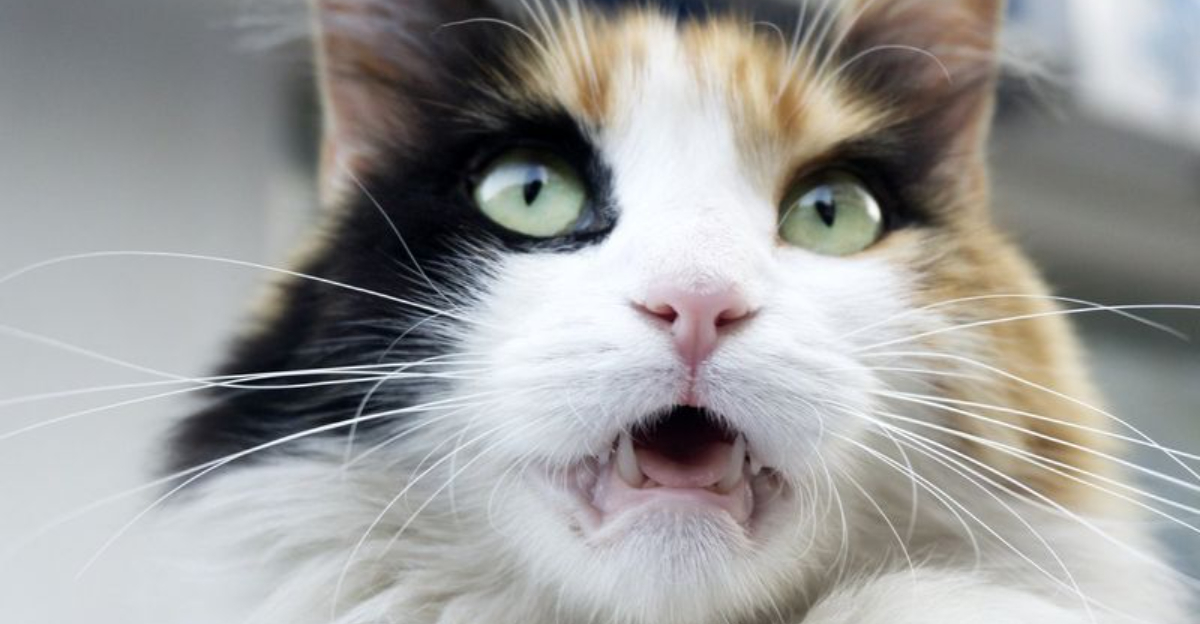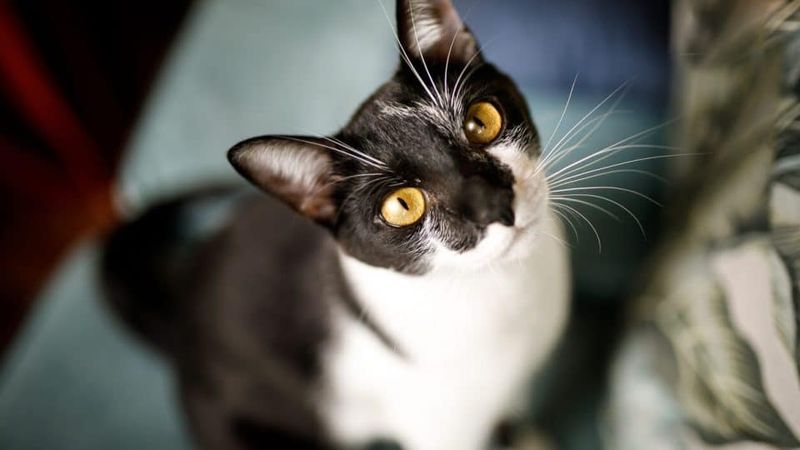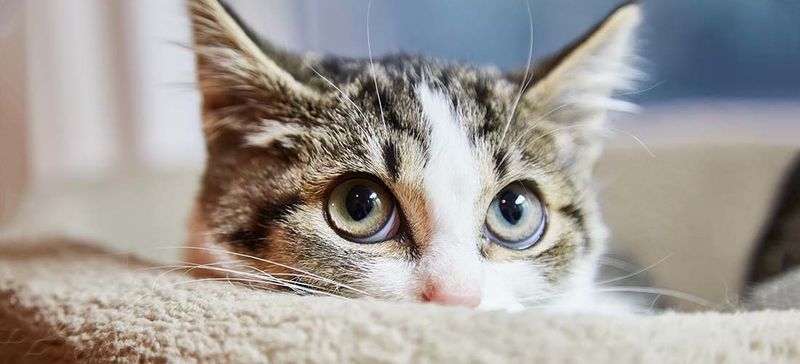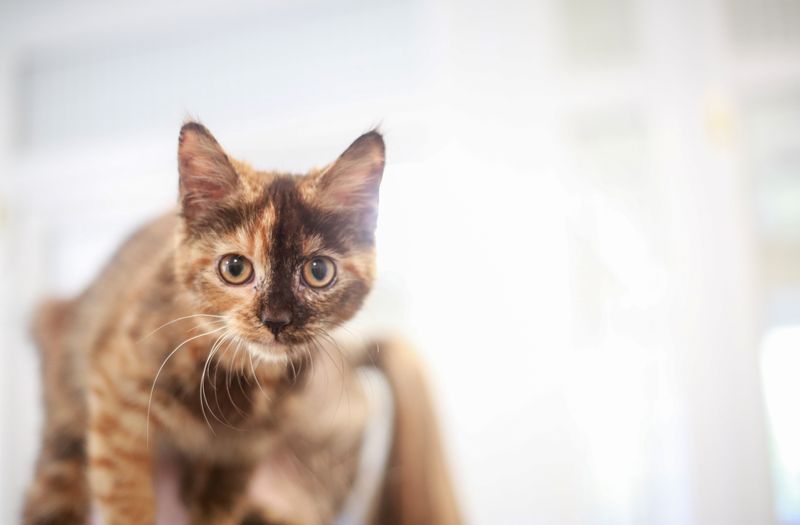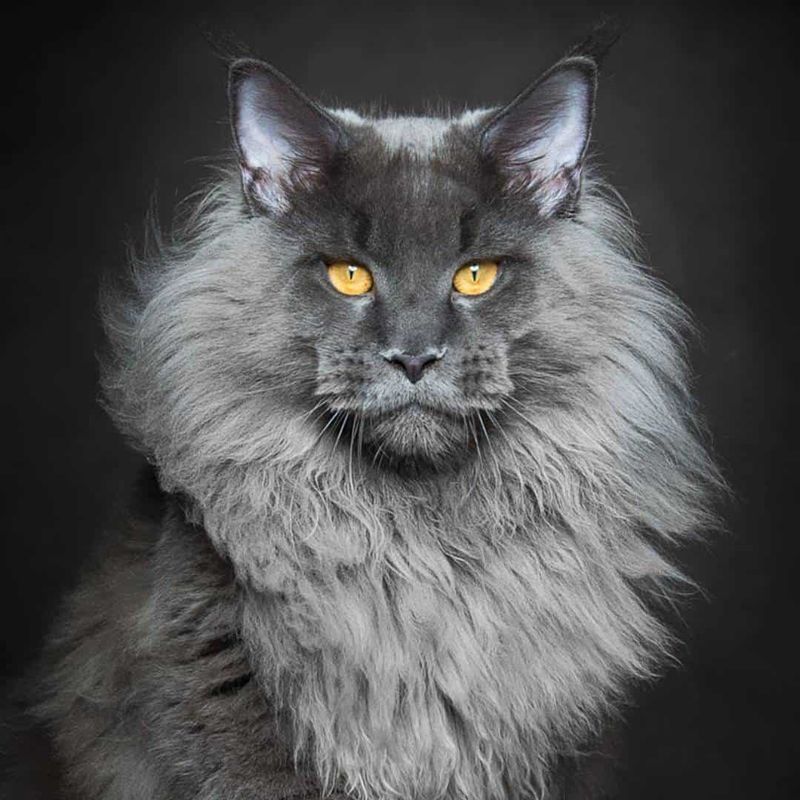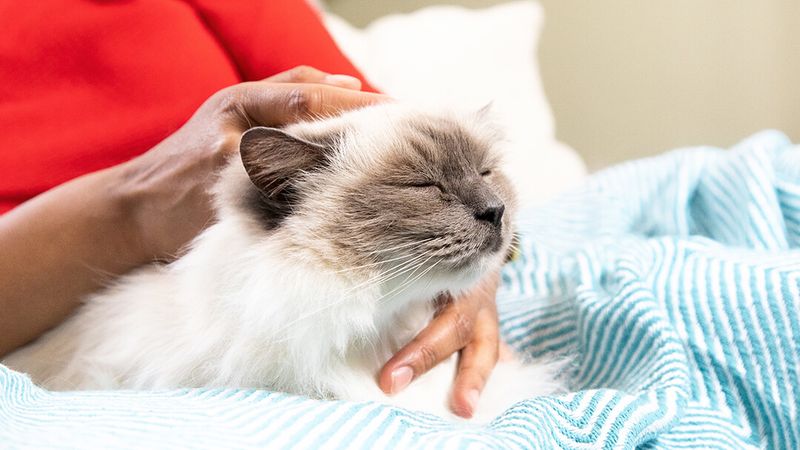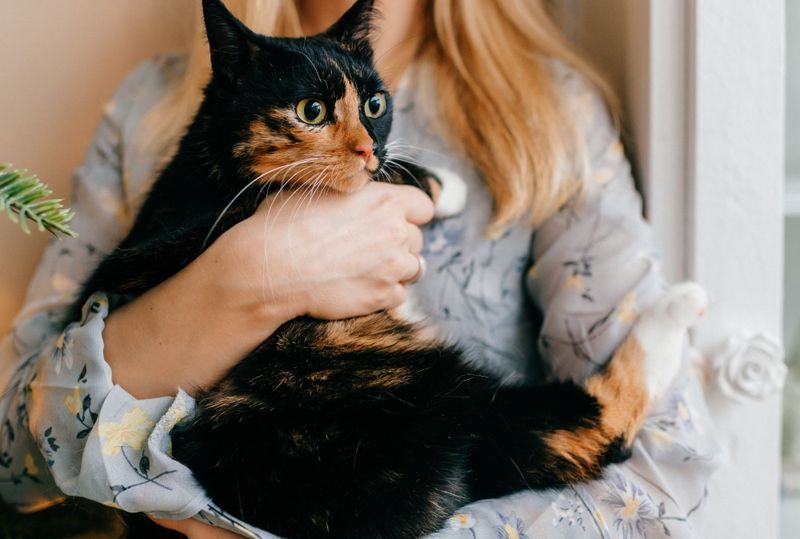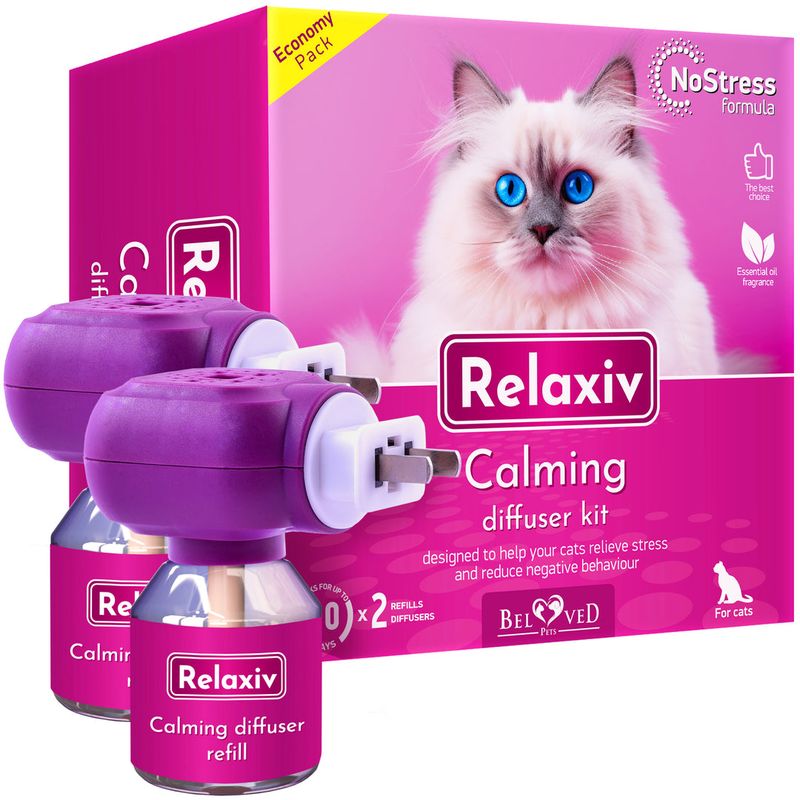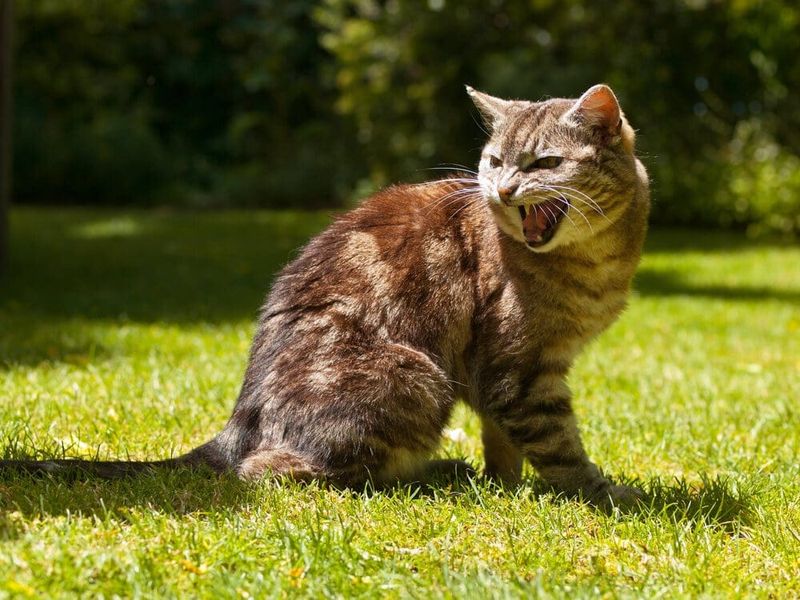📖 Table of Content:
- 1. Direct Eye Contact
- 2. Looming or Tall Posture
- 3. Fast or Jerky Movements
- 4. Strong Scents (e.g., from other animals)
- 5. Unfamiliar Facial Hair or Features
- 6. Large or Fluffy Animals
- 1. Avoid Direct Eye Contact
- 2. Use a Calm Voice & Gentle Movements
- 3. Give Space & Time
- 4. Pheromone Diffusers or Sprays
- 5. Environmental Enrichment
- 6. Consult a Vet or Behaviorist
One moment they’re purring on your lap, and the next, they’re hissing at the neighbor’s dog or giving you a good old swat for walking too close. While feline behavior can seem unpredictable, a lot of their reactions—especially aggressive ones—are influenced by what they see and sense in their environment.
Unlike dogs, cats are territorial creatures who rely heavily on body language and subtle cues. Certain physical traits—whether in people or other animals—can accidentally signal “danger” or “enemy” in their language. Understanding these triggers helps us become more empathetic and gives us a chance to create a safer, calmer space for our furry friends.
This article explores six physical traits that can unexpectedly trigger aggression in cats, along with six tried-and-true ways to manage or diffuse their sassy outbursts. Whether you’re a longtime cat companion or a newbie to the feline world, these insights will help turn hissy moments into purr-fect harmony.
1. Direct Eye Contact
To a cat, a lingering stare is more than awkward—it’s confrontational. When you lock eyes with a cat, especially one you don’t know well, it may interpret the gaze as a challenge. Cats in the wild use staring to assert dominance or mark threats, and your curious glance might be sending the wrong message. Even when cats trust their humans, they usually prefer blinks or soft glances over intense eye contact. That’s why a friendly cat may slowly blink at you—it’s their way of saying, “I trust you.” If you’re approaching a new cat, try softening your gaze and letting them come to you. Offering a few slow blinks is basically cat-speak for “I come in peace.”
2. Looming or Tall Posture
Towering above a cat can feel intimidating, even if you’re just standing casually nearby. Our feline friends are small and closer to the ground, so a person bending over or walking directly toward them might look like a predator. Instead of walking straight at them, try approaching from the side or crouching slightly to be less threatening. Posture matters: a relaxed body with slow, sideways movements is far more cat-friendly. Young children often unintentionally loom over cats, which can lead to defensive reactions. Educating little ones to sit calmly and let cats come to them can make a big difference. Cats thrive in environments where they feel in control of their space and interactions.
3. Fast or Jerky Movements
Quick gestures—like waving arms, sudden steps, or animated talking—can make even the most confident kitty feel startled. Cats are wired for survival and have lightning-fast reflexes, so any unexpected movement can kick their fight-or-flight instinct into gear. This is especially true if they’ve had past trauma or are naturally more cautious. Even playtime should be a balance between fun and not-overwhelming. Using calm, consistent body language reassures cats that you’re not a threat. Take a few deep breaths and let your actions mirror your calm energy. Cats are masters at reading body language, and slow movements build trust.
4. Strong Scents (e.g., from other animals)
Scents are a big deal in the cat world—more so than many people realize. If you come home smelling like a different pet, your cat might react with suspicion or even aggression. Their keen noses pick up on “intruders” easily, and if they feel their space has been compromised, tensions can rise. This is especially common in multi-cat homes or after vet visits. A great way to reduce this is by changing clothes or washing your hands before interacting with your cat. You can also use a familiar blanket or toy to reintroduce your scent in a comforting way. Scent swapping can be a helpful bonding tool, turning confusion into familiarity.
5. Unfamiliar Facial Hair or Features
Sometimes it’s the small things—like a new hat, a big beard, or even glasses—that can confuse or frighten a cat. Cats rely heavily on facial recognition and familiarity, and changes to your appearance may temporarily disrupt that recognition. You might look like a stranger until they realize it’s still you underneath the hat or scarf. Some cats get used to changes quickly, while others need a little patience and reassurance. If your cat seems standoffish after a style switch, try speaking in a soft voice they recognize. Gentle play or treats can also help rebuild the comfort they feel around you. Over time, your fashion experiments will be no big deal in their book.
6. Large or Fluffy Animals
Fluffiness might be adorable to us, but to a cat, a big, poofy dog (or even another cat) might look like a territorial threat. The bigger and more energetic the animal, the more likely a cat will feel cornered or provoked. Cats prefer slow introductions, especially when new pets are involved. Rushing the process can lead to hissing, growling, or even physical confrontations. Give your cat time to adjust by using scent swapping, visual introductions (like through a cracked door or gate), and rewarding calm behavior. Your cat’s confidence will grow once they realize the “fluff monster” isn’t out to take over their turf. Think of it as helping them make a new fuzzy friend at their own pace.
1. Avoid Direct Eye Contact
Looking away from a cat might feel odd, but it’s one of the kindest things you can do in a tense moment. Instead of staring, try a soft gaze or slowly blinking at them like you’re saying, “All is well.” Cats don’t naturally hold eye contact the way humans do—it’s more of a power move in their world. That’s why looking elsewhere helps them feel safe, not ignored. It’s especially important with shy or new cats, who are watching your every move for clues. A few calm blinks paired with stillness can work like magic to dissolve tension. With time, your cat will come to understand you’re no threat—and that builds lasting trust.
2. Use a Calm Voice & Gentle Movements
Speaking in a soft, soothing tone can help melt away a cat’s nervous energy. Your voice is one of the most comforting tools you have, especially when paired with slow hand movements or gentle gestures. Avoid yelling or laughing too loudly near a stressed cat—it can sound like chaos in their sensitive ears. The key is consistency: when your cat knows your voice equals safety, they’re more likely to relax. You can even talk to them like they’re a baby—many cats love high-pitched, affectionate chatter. A little sweet talk while you slowly sit or kneel can completely change the mood. You’re creating an emotional safe zone with every calm interaction.
3. Give Space & Time
Sometimes the best way to help is to step back and let your cat have a moment. Cats are incredibly independent creatures and often need solitude to process stress or confusion. Trying to cuddle or reach for them while they’re agitated can escalate the situation. Instead, give them access to a cozy spot—under a bed, in a box, or on a perch—where they feel secure. Watch from a distance and wait for them to approach you. This simple act of respect shows that you understand their boundaries. And in cat terms, that’s the ultimate form of friendship.
4. Pheromone Diffusers or Sprays
There’s a little science behind the magic of pheromone products, and they work wonders for many cats. These diffusers or sprays mimic natural “happy signals” cats release when they feel safe and content. Plug one into a room your cat frequents or spritz their favorite spot before a stressful event. The scent is undetectable to humans but provides powerful reassurance to cats. Great for multi-cat homes, vet visit prep, or just creating general zen vibes. Think of it like lighting a lavender candle—except it’s just for your feline friend. These small, invisible helpers can make a surprisingly big impact on reducing aggression.
5. Environmental Enrichment
A bored cat can quickly become a cranky cat, and aggression is often a sign of pent-up energy. Enrichment—through toys, climbing towers, window perches, and even food puzzles—keeps both body and brain engaged. Give them vertical space to feel confident and safe, especially if they share a home with other pets. Interactive toys like wand teasers or treat-dispensing balls can redirect frustration into fun. Switch things up regularly so they don’t lose interest in their surroundings. Even cardboard boxes and paper bags become exciting adventures in a well-curated kitty playground. A stimulated cat is a calmer, happier, and far less aggressive one.
6. Consult a Vet or Behaviorist
If your cat’s aggression is intense, frequent, or new, it might be time for professional support. Cats often mask pain, so aggression could be a sign something’s wrong physically. A trip to the vet can rule out conditions like dental issues, arthritis, or hormonal imbalances. If all looks clear medically, a certified feline behaviorist can assess things on the emotional level. These experts decode feline body language, triggers, and home dynamics to tailor a behavior plan. Think of it as a cat therapist—someone who speaks their language fluently. With their guidance, even the sassiest kitty can learn to find their calm again.
